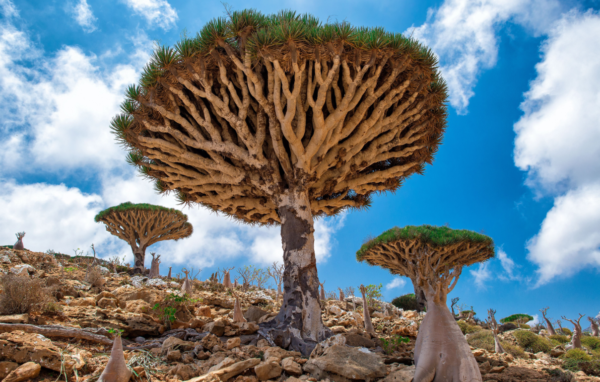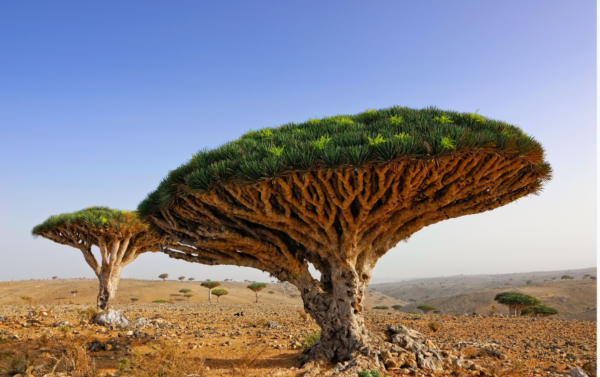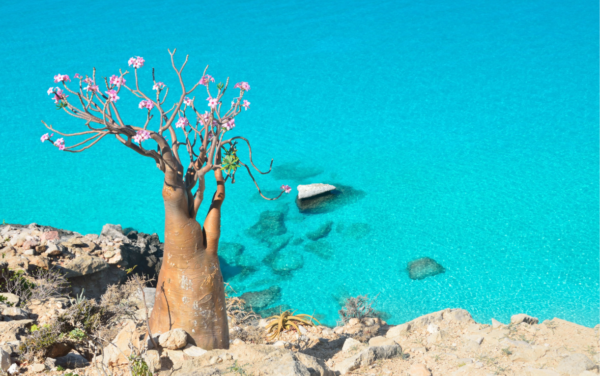Found some 240 kilometres east of the coast of Somalia and 380 kilometres south of the Arabian Peninsula, the island of Socotra is unusual in many ways. While politically part of Yemen, Socotra and the rest of its archipelago are geographically part of Africa.

Described as “the most alien-looking place on Earth”, the island is extremely isolated, and so is home to a high number of endemic species. In the 1990s, a team of biologists conducted a survey of the flora and fauna there, counting nearly 700 species found nowhere else on the planet. Only New Zealand, Hawaii and the Galapagos Islands have more than this.
Socotra measures 132 kilometres by 49.7 kilometres and is a historic place of trade dating back as far as the 1st century AD. It appears in the Periplus of the Erythraean Sea; a Greek navigation aid from that period and a wooden tablet were discovered there in the Palmyrene dialect dated to the 3rd Century AD, indicating the diversity of cultures who visited the island.
This diversity was fully realised in 2001, when a group of Belgian speleologists investigated a cave on the island and found a staggering number of inscriptions, drawings and objects left by ancient sailors who visited Socotra. The texts found were in Indian, Arabian, Ethiopic, Greek, Palmyrene and Bactrian languages.
It was in November 1967 when Socotra became part of South Yemen, and their relationship with the Soviet Union enabled the latter’s navy to use the archipelago as a base of operations between 1971 and 1985. Yemeni unification occurred in 1990 and the island has since been part of the Republic.
In 2015, Socotra was struck by the twin cyclones Chapala and Megh, which ravaged the island and caused devastation for the tiny population, who lost homes, roads and power. Despite receiving support from the United Arab Emirates at the time, Socotra was almost left abandoned and all-but forgotten by the world. When the UAE established a military base on the island, it caused rising tension between the remaining populace and the soldiers there, resulting in the only airport being seized. Eventually a deal was brokered and the tenuous alliance re-established.
Socotra is one of four habitable islands in the archipelago. The other three are Abd al Kuri, Samhah and Darsa. Socotra consists of narrow coastal plains, a limestone plateau and the Hajhir Mountains, which rise to 1,503 metres. With a warm climate across most of the year, the island does suffer monsoons frequently, which can cause strong winds and high seas. For many centuries, the sailors of Gujarat referred to the maritime route near Socotra as Sikotro Sinh, meaning ‘the lion of Socotra’ due to the constant roar of the waters.
The years of isolation, along with fierce heat and drought, have combined to create a unique and impressive endemic flora across the island. One of the most unusual plants is the dragon’s blood tree. Shaped like an umbrella, it was named because of its red sap, which is now used in paint and varnish. It was also used centuries ago for medicinal purposes.

Other impressive endemic plants on Socotra include the giant succulent tree, the cucumber tree and the rare Socotran pomegranate. These plants are what gives the island such an alien look, as visitors walk through a terrain unlike anywhere else on Earth.
The endemic fauna is just as interesting, too. The island is home to starlings, sunbirds, buntings, sparrows and golden-winged grosbeaks, all unique to Socotra. Unfortunately, many of these species are endangered now due to non-native feral cats roaming the wilds. However, with six endemic bird species and one endemic mammal in the Socotran bats, reptiles are the most widespread across the island with 31 different species. There are also several endemic spider species, including a distinctive tarantula, and three species of freshwater crabs.
Humans have been on the island for two thousand years and this has had a stark effect on the flora and fauna of course. In fact, reports have said that those creatures and plants that remain on Socotra represent a vastly degraded fraction of what once existed there. Ancient texts referred to crocodiles and larger lizards, all now gone, and Socotra once had larger wetlands which were home to water buffaloes in the early 17th century. The livestock currently on the island now threaten the remaining plants, while species introduced to Socotra (some by accident) are affecting the endemic animal population.
During the 2015 Yemen civil war, the people of Socotra were forced to cut down many of the island’s trees for wood to fuel their fires after gas prices became too high for them to purchase. In 2018, the UAE sent cooking gas to all residents of Socotra in order to stop the mass deforestation.
The island has an ancient tradition of poetry, which is down to the unbelievable number of languages spoken there over the years. Even today, an annual poetry competition is held on Socotra which attracts visitors from a wide variety of cultures.
Isolated islands such as Socotra may be uniquely beautiful, however it is inevitable that man’s encroachment will negatively affect the habitat unless it is carefully maintained. With the number of visitors steadily increasing each year as word spreads of this alien jewel, Socotra’s endemic biodiversity is at risk and the hope is that such an amazing wonder of our world will not fade away into the annals of history.








